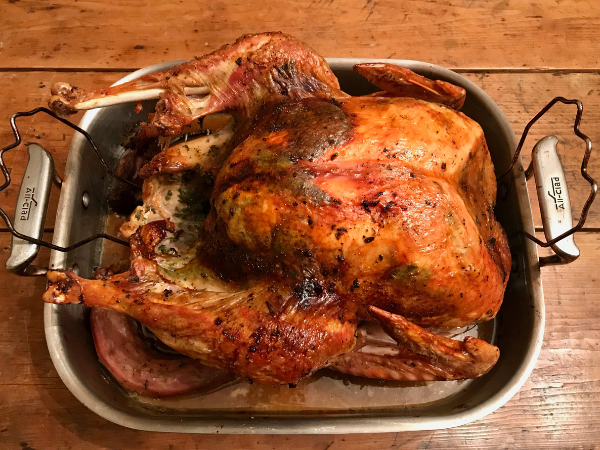Truth: real roast turkey is not dry, tough and tasteless. Yet, every Thanksgiving…Americans expect that “dry” is what’s “normal” for roast turkey.
Years ago, my husband and I were invited to a Thanksgiving dinner where the host had labored over the turkey for the better part of two days. It had been marinated overnight, massaged, and frequently basted while it roasted in the oven for countless hours (at least 8!). When our host finally deemed it “done” and took it out of the oven, the turkey, with its picture-perfect bronzed sheen, would have made Martha Stewart swoon. That night, it elicited “ahhs” from all the guests.
But looks can be deceiving. Our anticipation quickly gave way to disappointment as we carefully gnawed our way through what turned out to be a very tough, dry bird—and politely declined seconds.
For the last 12 years, I’ve taken my cue for preparing my Thanksgiving turkey from James Peterson, chef, culinary arts teacher and author of Glorious French Food.
4 Tips for a Tender Bird:
1. Buy a quality turkey.
It starts with the bird, itself. Ideally, if you can, it’s worth splurging on a free-range organic turkey or a heritage breed turkey. We buy an all-natural (no GMO feed) turkey from a local farm, where it’s processed on-site, not far from our house upstate.
2. Cover the breast.
Breast meat dries out quickly. Cover the breast with aluminum foil the first 45 minutes of cooking.
3. Do NOT stuff the bird.
Stuffing it ensures a longer cooking time—and a dry turkey.
4. Do NOT overcook.
Like Peterson, I cook my turkey (unstuffed), about 8 to 10 minutes per pound, or until a thermometer inserted the hollow area between the thigh and leg reaches 150 to 160 degrees. So, for example, a 10-pound turkey would take 80 minutes (1 hour and 20 minutes) to 100 minutes (1 hour and 40 minutes) to roast, in total.
The USDA recommends cooking to an internal temperature of 180 degrees, which might make sense if you buy a typical commercial Thanksgiving turkey, which is raised in a high-density confinement facility, where it endures overcrowding, poor sanitation and lack of access to outdoor space. But, if you buy a quality turkey, there is no need to cook to such a high temperature (because killing pathogens is not a primary concern.)
For over a decade, I have been cooking our Thanksgiving turkey to 150 degrees—and I’m still standing. I’ve never experienced any ill effects.
Only juicy, super-tender roast turkey meat…just the way it should be.
Keep it simple, and you’re guaranteed a delicious end result.. That’s why an herb-rubbed turkey graces our table every Thanksgiving—see recipe below.
Herb-Rubbed Turkey with Jus
ONE DAY AHEAD
For the garlic-herb rub:
2 cup fresh flat-leaf parsley, chopped
2 cup fresh sage leaves
1 cup fresh rosemary leaves
1 cup fresh thyme leaves, save the woody stems
22 garlic cloves, or to taste (I like garlicky)
Place all rub ingredients into a food processor and process until finely minced.
For the marinade:
Juice of 4 organic lemons, strained of any pulp
For the turkey:
You’ll have enough garlic herb rub for a 10 to 12 pound organic, all-natural or heritage breed turkey. Use less or make more for a smaller / larger turkey.
Remove and discard giblets and neck from turkey. Rinse turkey with cold water; pat dry with paper towels. Trim excess fat. Place turkey in a large non-reactive bowl (glass or stainless steel). Starting at neck cavity, loosen skin from breast and drumsticks by inserting fingers, gently pushing between skin and meat.
Season turkey under and over skin with Celtic sea salt and freshly ground black pepper.
Spread garlic-herb rub under the loosened skin (breast, back, thighs, legs). Lift wing tips up and over back, tuck into turkey. Pour lemon juice under the skin (and over the herbs). Refrigerate at least 8 hours or overnight.
About 45 minutes to an hour before roasting, take the turkey out of the refrigerator and allow it to come to room temperature.
Preheat oven to 350°F.
Spread sliced onions on the bottom of a heavy-bottomed roasting pan (to prevent sticking) and place a fitted rack on top.
Brush skin of entire turkey with 2 tablespoons of melted coconut oil. Carefully transfer turkey to the rack. Place a coconut oil-brushed, triple-thick sheet of aluminum foil—greased side down—over turkey’s breast bone. Position the roasting pan so that the turkey’s legs face the back of the oven and the bird, breast side-up, faces you. Roast 45 minutes, then remove foil from breast to allow the skin to brown.
Turn the roasting pan around and roast turkey another 45 minutes to 1 hour (calculate apx. 8 minutes per pound), or until a thermometer inserted in the hollow area between the leg and breast registers 145°-150°F (the cavity should register 140°F). Keep in mind the temperature will rise another 5°F as the turkey rests.
Transfer turkey to a platter and allow it to rest for 20 -30 minutes.
Reserve pan drippings. Strain out fat, if desired. Drizzle turkey jus over sliced turkey.


